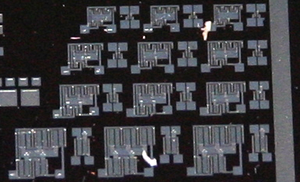Ring oscillator

A ring oscillator is a device composed of an odd number of NOT gates whose output oscillates between two voltage levels, representing true and false. The NOT gates, or inverters, are attached in a chain; the output of the last inverter is fed back into the first.
Contents
[hide]Details
Because a single inverter computes the logical NOT of its input, it can be shown that the last output of a chain of an odd number of inverters is the logical NOT of the first input. This final output is asserted a finite amount of time after the first input is asserted; the feedback of this last output to the input causes oscillation.
A circular chain composed of an even number of inverters cannot be used as a ring oscillator; the last output in this case is the same as the input. However, this configuration of inverter feedback can be used as a storage element; it is the basic building block of static random access memory, or SRAM.
A real ring oscillator only requires power to operate; above a certain threshold voltage, oscillations begin spontaneously. To increase the frequency of oscillation, two methods may be used. Firstly, the applied voltage may be increased; this increases both the frequency of the oscillation and the power consumed, which is dissipated as heat. The heat dissipated limits the speed of a given oscillator. Secondly, a smaller ring oscillator may be fabricated; this results in a higher frequency of oscillation given a certain power consumption.
Operation
To understand the operation of a ring oscillator, one must first understand gate delay. In a physical device, no gate can switch instantaneously; in a device fabricated with MOSFETs, for example, the gate capacitance must be charged before current can flow between the source and the drain. Thus, the output of every inverter of a ring oscillator changes a finite amount of time after the input has changed. From here, it can be easily seen that adding more inverters to the chain increases the total gate delay, reducing the frequency of oscillation.
The ring oscillator is a member of the class of time delay oscillators. A time-delay oscillator consists of an inverting amplifier with a delay element between the amplifier output and its input. The amplifier must have a gain of greater than 1.0 at the intended oscillation frequency. Consider the initial case where the amplifier input and output voltages are momentarily balanced at a stable point. A small amount of noise can cause the amplifier output to rise slightly. After passing through the time-delay element, this small output voltage change will be presented to the amplifier input. The amplifier has a negative gain of greater than 1, so the output will change in the direction opposite to this input voltage. It will change by an amount larger than the input value, for a gain of greater than 1. This amplified, reversed signal propagates from the output through the time-delay and back to the input, where it is amplified and inverted again. The result of this sequential loop is a square-wave signal at the amplifier output with the period of each half of the square wave equal to the time delay. The square wave will grow until the amplifier output voltage reaches its limits, where it will stabilize. A more exact analysis will show that the wave that grows from the initial noise may not be square as it grows, but it will become square as the amplifier reaches its output limits.
The ring oscillator is a distributed version of the delay oscillator. The ring oscillator uses an odd number of inverters to give the effect of a single inverting amplifier with a gain of greater than one. Rather than having a single delay element, each inverter contributes to the delay of the signal around the ring of inverters, hence the name ring oscillator. Adding pairs of inverters to the ring increases the total delay and thereby decreases the oscillator frequency. Changing the supply voltage changes the delay through each inverter, with higher voltages typically decreasing the delay and increasing the oscillator frequency.
Applications
- The voltage-controlled oscillator in most phase-locked loops is built from a ring oscillator.[1]
- A ring oscillator is often used to demonstrate a new hardware technology, analogous to the way a hello world program is often used to demonstrate a new software technology.[2][3]
- Many wafers include a ring oscillator as part of the scribe line test structures. They are used during wafer testing to measure the effects of manufacturing process variations.[4]
- Ring oscillators can also be used to measure the effects of voltage and temperature on a chip.[5]
See also
Notes
| 40x40px | Wikimedia Commons has media related to Ring oscillators. |
Cite error: Invalid <references> tag;
parameter "group" is allowed only.
<references />, or <references group="..." />- Jump up ↑ "A Performance Prediction of Clock Generation PLLs: A Ring Oscillator Based PLL and an LC Oscillator Based PLL"
- Jump up ↑ Slashdot Science: "IBM Creates Ring Oscillator on a Single Nanotube"
- Jump up ↑ Slashdot Hardware: "World's First Completely Transparent IC"
- Jump up ↑ "Ring oscillators for CMOS process tuning and variability control" by BHUSHAN Manjul; GATTIKER Anne; KETCHEN Mark B.; DAS Koushik K.
- Jump up ↑ "Analysis of a ring oscillator based on-chip thermal sensor"

